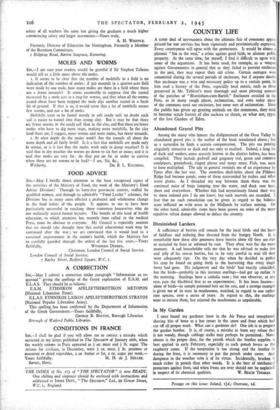MOLES AND WORMS
StR,—I am sure your readers would be grateful if Sir Stephen Tallents would tell us a little more about the moles.
1. It seems to be clear that the number of molehills in a field is no indication of the number of moles: if 302 mounds in a quarter-acre field were made by one mole, how many moles are there in a field where there ere a dozen mounds? It seems reasonable to suppose that the tunnel excavated by a mole acts as a trap for worms, and that when all the worms round about have been trapped the mole digs another tunnel in a fresh bit of ground. If that is so, it would seem that a lot of molehills means few worms, and not a lot of moles.
Molehills seem to be found mostly in soft sandy soil; no doubt such soil is easier to tunnel into than strong clay. But it may be that there are fewer worms in the sandy soil than in the clay, and that there are fewer moles who have to dig more traps, making more molehills. In the clay land there are, I suggest, more worms and more moles, but fewer mounds.
2. At what depth do the moles work? Are the tunnels all about the same depth and all fairly level? Is it a fact that molehills are made only in winter, or is it just that the moles work only in damp weather? It is said that in dry weather the worms go down to six feet or more; and it is said that moles are very fat: do they put on fat in order to survive when there are no worms to be had?—I am, Sir, &c.,


























 Previous page
Previous page